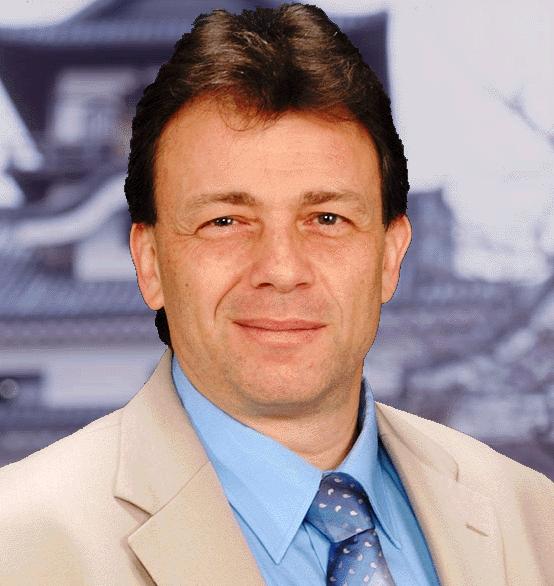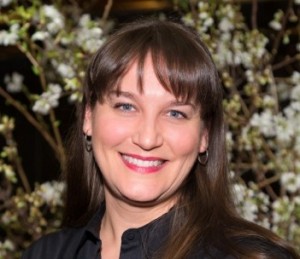JQ Magazine: JQ&A with Web Entrepreneur Vanessa Villalobos
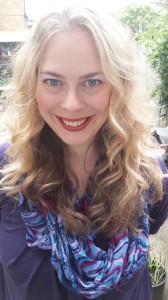
“If you create businesses based on your own experience and enthusiasms, you’ll never tire of them. Be sure to network with JETAA to stay in touch with people who are interested in Japan.” (Courtesy of Vanessa Villalobos)
By Rafael Villadiego (Nagasaki-ken, 2010-13) for JQ magazine. A member of JETAA New South Wales, Rafael is a collector of words on a journey still searching for a destination, who has a tendency to forget, we are all sometimes like the rain…
Like many JET alums, Vanessa Villalobos (Tochigi-ken, 2000-03) thoroughly enjoyed her time in Japan and was seeking a practical means to maintain that connection upon returning home. Seeking to recapture her experiences on the JET Program and maintain her Japanese language skills after returning to the United Kingdom, she founded the travel/lifestyle/culture site JapaneseLondon.com and the language exchange hub, IsshoniLondon.co.uk.
As an independent businesswoman and entrepreneur, she offers some advice to JQ readers seeking to pursue their own ventures and shares some insight into the trials and tribulations of language exchange. She also offers insider tips to discovering the hidden Japan in London along with the colorful contrasts between the two island nations, her thoughts on the recent vote for Scottish independence, and her take on the UK version of nattō.
How long did you spend on the JET Program and in which prefecture were you placed?
I was a “one-shot” ALT in Tochigi-shi for three years. Tochigi-ken is north of Tokyo and is famed for Nikko, strawberries and gyoza.
How did your time on JET influence the overall design and purpose of the websites?
Japan was endlessly fascinating to me, and I loved teaching Japanese learners of English. Thus, I chose to focus my business endeavors on connections between Japan and England.
IsshoniLondon.co.uk connects private tutors of English to Japanese learners of English. Most of the tutors are ex-JETs. In my intro video on the site, I explain how the kindness of friends and teachers in Japan allowed us teachers to develop an understanding and fondness for Japanese language and culture, and how we hope Japanese people will develop the same fondness of the UK. I am always looking for top-quality tutors, so please do get in touch if you’d like to work as a freelance tutor.
JapaneseLondon.com does what it says on the can! It’s a labour of love and is all about discovering Japanese things in London. It promotes and profiles the individuals, events and businesses that together make up “JapaneseLondon”! There is an events calendar, and I’ve just added a job board. Please do sign up to the newsletter on the site! JapaneseLondon.com can also connect you to a tutor of Japanese here in London!
Do you have any advice for JETs looking to setup similar initiatives in their hometowns?
Just get stuck in—and don’t give up. If you create businesses based on your own experience and enthusiasms, you’ll never tire of them. Staying power is important as it is sooo hard to build your own business from scratch. But it is deeply satisfying at the same time! Be sure to network with JETAA to stay in touch with people who are interested in Japan.
Justin’s Japan: Interview with Yoshiki of X Japan on the Band’s Madison Square Garden Debut
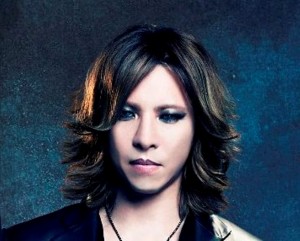
“At an X Japan show, we create a show with the audience—it’s not ‘the band is performing and the audience is just watching,’ so we create the show together. We’re going to try to make Madison Square Garden like a huge club.” (Courtesy of ID PR)
By JQ magazine editor Justin Tedaldi (CIR Kobe-shi, 2001-02) for Examiner.com. Visit his Japanese culture page here for related stories.
For Yoshiki Hayashi, this Saturday (Oct. 11) will go down in J-rock history, as one of the biggest bands in Asia makes their debut at Madison Square Garden. Formed over 30 years ago, X Japan first gained notoriety in the mid-’80s by ushering in the visual kei movement, a style that continues to evolve through other Japanese megastars like L’Arc~en~Ciel (who headlined the World’s Most Famous Arena themselves in 2012).
At the center of it all is X Japan’s founding member, Yoshiki. An equally talented songwriter, heavy metal drummer and classical pianist, he is both the heart and soul of X Japan, and, having lived in Los Angeles for two decades, the ideal mouthpiece for the band’s American tours, which started with a bang in 2010 at Lollapalooza and included a sold-out gig at New York’s now-defunct Roseland Ballroom.
In this exclusive, expansive interview, I spoke with Yoshiki about how the group’s original hopes to play the Garden in 2008 were dashed by personal health and management troubles, his favorite, anime, manga and X Japan songs, and his experience working with legends like Stan Lee, KISS, and the Emperor of Japan.
How did this concert for Madison Square Garden come together? I know there were plans to do this in 2008; can you talk about this history?
Our band reunited around the year 2008. We did our reunion concert in Tokyo Dome, three days or so, I think. At that time, we were also thinking of performing [shows] outside of Japan, and Madison Square Garden was one or two of [the ideas]. But for some reason they didn’t happen, so since then, that venue was always in our minds. A few years ago, we decided to try schedule Madison Square Garden. I think we were kind of confirmed last year.
It’s a long road.
Yes. Well, considering that X Japan was not doing anything—I mean, the band broke up around the end of 1997, so when we reunited we had almost 10 years of a break. We started doing a bunch of arena shows, and then we started touring the world when we went to 16 countries or so. Considering this, the [last] six or seven years have been tours [laughs].
Are there plans for X Japan to play any other concerts for the remainder of the year?
Not now. We just announced our shows in Japan, this place called Yokohama Arena, so we [performed] there Sept. 30 and Oct. 1. It’s kind of like a prelude to Madison Square Garden and a kickoff to [that] show, about 10 days before that. As of now, Madison Square Garden is the only American show, but [depending] on how it goes, we may start another world tour. We’re just talking about it right this moment.
For the complete story, click here.
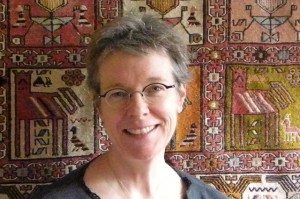
“Hopefully the lines between my actual experiences and pure fiction are seamless. When readers ask me, ‘Is this part true?’ they seem surprised by the answers. So that makes me happy—the fiction is believable and sometimes the outrageous is the truth.” (Courtesy of William Fraser)
By Rafael Villadiego (Nagasaki-ken, 2010-13) for JQ magazine. A member of JETAA New South Wales, Rafael is a collector of words on a journey still searching for a destination, who has a tendency to forget, we are all sometimes like the rain…
Laurie Fraser (Osaka-fu, 1997-98) is a writer and traveler who married a Kurd in Turkey in the 1990s. The experience inspired The Word Not Spoken, semi-autobiographical debut novel that blurs the line between reality and fiction, casting light on a tumultuous period in history through the eyes of those who experienced it firsthand.
The conflict between the PKK [Kurdistan Workers’ Party] and the Turkish Armed Forces has its roots in the First World War and continues to have repercussions for the region to this day. But beyond these grand struggles are the quiet moments in between: The ordinary challenges and trivial frustrations of everyday life, and the more overarching issues of culture and religion, which Fraser approaches with a genuine curiosity and gentle humor that forms the emotional core of her book.
An extensive traveler to a number of different countries across the globe, Fraser has experienced life in the broadest context before eventually finding her way “home.” Now a teacher and healer in Ottawa, JQ caught up with her to discuss the events of her life that inspired the novel and how they contrasted with her time on the JET Program.
What led you to first write this novel, and why did it take so long for the finished work to see light?
The scene where Ahmet and Leigh meet a group of destitute Kurdish refugees is exactly true, except that it happened in 1996, not 1995. I decided then to write a book and tell their story in a way that wasn’t “bad news.” At that time, my husband believed that the world would never hear about the Kurds if the PKK wasn’t setting off bombs. I recognized that as a Canadian, I had a right that he did not—the right to free speech.
I am a poet at heart, and I found a novel to be unwieldy to say the least. I had the poet’s need to touch every word over and over—so that slowed me down.
The Word Not Spoken was refused by countless publishers—I had a stack of rejection letters collected just in the year I was in Japan. It did well in a Canadian national writing contest in 2000, but only the winner was published. I was incapacitated with illness for a few years, but I eventually did a huge rewrite in 2010-11 with a professional editor. The manuscript did get better and better over the years, but it wasn’t until self-publishing became accessible and respected that I finally decided to go for it on my own.
I promised those refugees and my husband (who was killed in 1997) that I would publish their stories and really, it was a stone in my stomach for 18 years.
Kurdish House in Vancouver flew me out there (from Ottawa) to read to a large Kurdish audience this past spring. Afterwards, men and women came to talk to me: “I lived in one of those tents for four years.” “I was tortured 45 days.”
I have been haunted by the refugees I met living in those tents in 1996. I couldn’t imagine how any of them would have survived. These Vancouverites were an affirmation of life—some of them had made it! Some of them would have been children in 1996…and here they were! All I could say was, “I’m so glad you got here. I prayed for you.” And indeed, I wrote a book for them.
JQ Magazine: JQ&A with Mark Deyss of Marist Brothers International School in Kobe
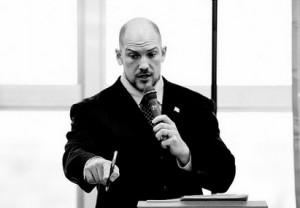
“When students do right, let them know about it and make sure to tell their parents, too. Show students that although you may have high expectations, you are fair and reasonable. Love what you teach and that excitement will transfer to students. These are some things that I found go into successful teaching.” (MBIS, courtesy of Flickr)
By Lyle Sylvander (Yokohama-shi, 2001-02) for JQ magazine. Lyle has completed a master’s program at the School of International and Public Affairs at Columbia University and has been writing for the JET Alumni Association of New York since 2004. He is also the goalkeeper for FC Japan, a New York City-based soccer team.
A native of Delmar, New York, Mark Deyss (Yokohama-shi, 2001-02) is a history and social studies teacher at Marist Brothers International School in Kobe, which has been a historic institution for the Kansai region’s pre-K through 12th children since 1951. Married with two young children, Mark is also a competitive bodybuilder in his spare time.
In this expansive interview, Mark spoke with JQ about how a visit to Iowa landed him his job, the unique benefits and challenges that go with teaching and living long-term in Japan, and some surprising misconceptions about bodybuilding.
What sparked your interest in Japan? Were you always interested growing up, or was it more of a curiosity thing?
I didn’t have a real interest in Japan per se. I was more interested in teaching in Indonesia (Bali, to be specific) or Thailand (Phuket). Both those places seemed pretty cool and exotic to a 22-year-old fresh out of college (SUNY Oswego). But what the hell does a 22-year-old know?! In the end, I backed away from those locations because from what I could tell, you needed to actually go to the place and start knocking on doors at language schools to find a job. That was a little too much adventure for me. A professor at my college mentioned AEON. I looked into it and it turned out that I could interview with them right in New York City. They gave me a contract to look over before I actually went to Japan and they seemed much more legitimate in general. That’s how my interest in Japan developed—as a conservative alternative to Bali.
Can you tell us about the conversation school you taught at in Japan before you joined JET?
I first came to Japan in September 1998 to work with AEON. Like most people who knew nothing about Japan, I requested to be located in Tokyo (in fairness to myself, I did actually know a couple of people in Tokyo, which is part of the reason for the request). AEON said they didn’t have anything in Tokyo open, but put me as close to Tokyo as possible—Hiratsuka City, in Kanagawa-ken. It worked out for the best, as most things in life do. I was with AEON for a year before taking a job (for a lot more money!) with another small eikaiwa outfit named Proto, which was actually run by a car parts manufacturer named Nippon Seiki (amongst other things they make dashboard and instrument panels for the “All-American” Harley Davidson and Chevrolet Corvette). Proto was located in Nagaoka, Niigata, surroundings that were much different than the urban congestion of Kanto. I was with Proto for about a year and a half before I came back to Kanagawa (Yokohama) for JET.
What did you do after JET?
I went to NYC to attend graduate school (education) at Queens College. Those years were indeed the hardest of my life, but my trials weren’t related to Queens College per se, more just being a scared young adult with an uncertain future and a tenuous present! Queens College served its purpose well and gave me the wonderful experience of living in Flushing, New York.
While attending the college, I taught at The Summit School, located in Jamaica, New York. It is a pretty good school for learning disabled and emotionally disturbed kids. I already had some experience working with that population of students before I went to Japan for the first time (summer job), so it was not an unfamiliar thing for me. That job served its purpose and provided me with enough money (barely enough!) to pay rent, eat three meals a day and get out of grad school debt free.
Justin’s Japan: Interview with James Rolfe of Cinemassacre on ‘Angry Video Game Nerd: The Movie’
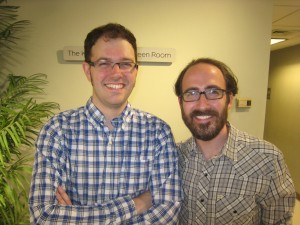
James Rolfe, left, on the Angry Video Game Nerd movie with co-writer/co-director Kevin Finn: “To me, it’s the ultimate fan-film. It’s made by fans, for fans. It means dreams can come true, with a lot of hard work and personal sacrifice.” (Justin Tedaldi)
By JQ magazine editor Justin Tedaldi (CIR Kobe-shi, 2001-02) for Examiner.com. Visit his Japanese culture page here for related stories.
An Internet sensation that debuted as the Angry Video Game Nerd ten years ago, filmmaker James Rolfe has taken millions of YouTube visitors back to the past with his hotheaded, foulmouthed alter ego, who gleefully tears down some of the most notorious titles and accessories (the Power Glove, anyone?) from the golden age of retrogaming. (If you’ve ever thrown a controller across the room, you’ll understand.)
As the creative linchpin of his website and production company Cinemassacre, the AVGN legend culminates with this year’s release of Angry Video Game Nerd: The Movie, a feature-length, years-in-the-making collaborative effort between Rolfe and co-writer/co-director Kevin Finn. A satisfyingly silly sci-fi/adventure hybrid in the Troma tradition, the film enjoyed a sold out 16-city North American screening tour earlier this summer, and makes its Vimeo on Demand debut today (Sept. 2), with a DVD/Blu-ray release planned for the holiday season.
In this exclusive, wide-ranging interview, I spoke with Rolfe about everything from the film’s New York premiere last month, the Nerd Renaissance we’re currently living in, and the most “Japanese” (i.e., insane) game he’s ever played.
It feels like we’re living in some kind of Nerd Renaissance—even “Weird Al” Yankovic’s last album went to number one. How do you feel about all this?
Nerds were big in the ’80s. It’s all coming back now. I feel there’s a much broader definition of “nerd” now, and it’s something to be proud of.
What are your thoughts on the live appearances you’ve had promoting the film so far? Which moments have been the most memorable?
Since July 21, we’ve been touring this movie around, city by city. It’s been amazing. The energy from the crowd is fantastic! There’s nothing like watching the movie with live reactions. The best moment is during the opening credits. Everyone cheers. Sometimes they clap along with the music. You can really feel the hype building up to the AVGN title screen. Then it explodes, and everyone goes nuts.
What can you share about the back-to-back screenings held for the New York premiere?
It was a rowdy crowd. Especially the second screening. I loved it, though it was exhausting. Under normal circumstances, I would be sick of looking at this movie, but the fans make it exciting every time. It never gets old.
Mount Fuji and Godzilla movies play a prominent role in the film. If you were to ever visit Japan, what would you most want to see and do there?
I’ve always wanted to go. There isn’t one thing in particular. I’d just like to see all around the major cities like Tokyo. Just normal tourist things.
What are some of your favorite moments of “Japaneseness” in video games that you’d like to give a shout-out to?
Hmmm. Not sure. Probably Ninja Baseball Bat Man! That game is insane.
For the complete story, click here.
JQ Magazine: JQ&A with John Gaunter on ‘Sake Confidential’
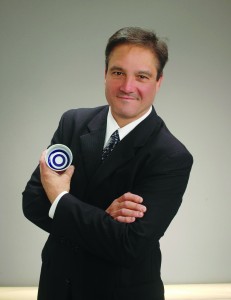
“Sake is so deep and varied that one could never stop talking about it. Every day is full of surprises. Not major ones, but usually surprises related to the attention to detail that goes into sake and the interesting stories behind it.” (Courtesy of John Gauntner)
By Eden Law (Fukushima-ken, 2010-11) for JQ magazine. Eden is a JETAA New South Wales committee member, who would like it to be known that if it wasn’t for getting involved with JETAA, he wouldn’t know what to do with his spare time after hours. JET: It’s like the Illuminati, except less about the world domination and more about the fun denomination. Got feedback on this article? Leave a comment below.
If ever there was a prize for most unexpected job opportunity spin-off from the JET Program, the career of John Gauntner (Kanagawa-ken, 1988-89) would be hard to beat, especially after a few rounds of nihonshu. A longtime resident of Kamakura and the world’s first (and only) non-Japanese to hold certification as both a Master of Sake Tasting and Sake Expert Assessor, Gauntner has come a long way since a drinking session with a buddy from The Japan Times led him to this series of fortunate events.
Proving that this beverage continues to be an infinite font of inspiration, Gauntner has recently added a new book to his growing stable of literary output, Sake Confidential: A Beyond-the-Basics Guide to Understanding, Tasting, Selection, and Enjoyment. In it, he covers all aspects of the precious drop: from what it is, how it is made, and how it is meant to be enjoyed (spoiler: any way you like it), to the inside story of its politics, marketing, and the industry itself. But this is no textbook: Like a true sake evangelist, Gauntner enlightens beginners and insiders alike, pairing clear and simple language with confidence and unabashed passion.
In this exclusive interview, Gauntner discusses the state of sake’s popularity in its own country and abroad, what it means being a non-Japanese sake evangelist with his unique qualifications, and what the future holds for him.
What was the reason behind writing this book, and who is its audience?
I wanted to show the depth and breadth of the sake world, to show it has as many avenues for exploration as wine does.
How is this book different from the others?
This book goes beyond the basics and more into depth about many interesting side topics of the sake world.
Is this book designed to replace or update your previous books?
No, it is intended to augment them. This one introduces less sake and is light on the basics,
What’s the market like for these books?
So far it is selling well, but ask me in two years!
What’s left to be said about sake? Are there any surprises left in the industry?
It is so deep and varied that one could never stop talking about it. Every day is full of surprises. Not major ones, but usually surprises related to the attention to detail that goes into sake and the interesting stories behind it.
JQ Magazine: JQ&A with Trixie Cordova, Peace Boat US Volunteer Staff and World Up Education Director
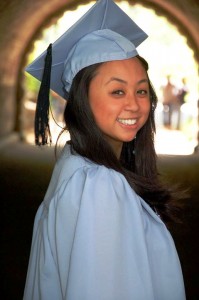
Trixie’s advice for new JETs: “Soak it in! Challenge yourself to try new things, explore the country, eat crazy foods, GET NAKED (at an onsen, anyway). Appreciate how different and preserved Japanese culture truly is, and don’t take your time abroad for granted. You were a chosen one, so embrace it!” (Courtesy of Trixie Cordova)
By Mark Flanigan (Nagasaki-ken, 2000-04) for JQ magazine. A member of the JET Alumni Association of New York’s board of directors, Mark is a program director at the Japan ICU Foundation in New York City and was also a Rotary Peace Fellow at ICU from 2010-12, during which time he volunteered for a tsunami relief mission in Ishinomaki after the terrible 3/11 tragedy. He can be contacted at mflanigan[at]jicuf.org.
Trixie Cordova (Shimane-ken, 2007-09) began volunteering with Peace Boat US in New York since last October. A civil society and non-profit organization, Peace Boat US works to promote peace, sustainable development, human rights and respect for the environment throughout the United States and the world through educational programs organized in partnership with the Japanese NGO Peace Boat, which carries out its main activities through a chartered passenger ship that travels the world on peace voyages.
At the same time, Cordova has served as education director for World Up, a non-profit organization based in Brooklyn that uses music, specifically hip-hop, and technology education to explore local and global issues affecting youth today. A graduate from Teachers College at Columbia University with a Master’s in International Educational Development, concentrating on Peace Education, Cordova has been quite active in JETAANY as well, serving on a career panel for recently returned JETs this past year. Prior to living and working in New York, she taught English in rural Japan for two years, where she first learned about Peace Boat while on the JET Program.
As a Peace Boat US volunteer, Cordova has been working toward creating opportunities for New York youth to participate in the Music and Art Peace Academy (MAPA) Program on board the ship. This summer, she will work closely with Unique Waters of World Up’s after-school music program “WU School” at the Brooklyn Community Arts and Media High School. Together they will lead music and leadership-based activities to promote cross-cultural understanding and to collaborate on a musical soundtrack to MAPA this summer.
JQ reached out to Cordova recently to ask her more about how her experiences in Japan and the Peace Boat-JET connection has led to this sea change in global education.
Thanks for taking the time to share your story, Trixie! Where and when were you placed on JET? Was it your first time in Japan?
Sure thing! I was an elementary and JHS ALT in Gotsu, Shimane, from 2007-09. Shimane’s claim to fame is that it isn’t famous—check out their unofficial mascot, Yoshida-kun, as proof! It was definitely my first time to Japan—I never studied the language or the culture before setting foot in Tokyo for JET orientation.
What was perhaps the biggest misconception you had about Japan before your experience on JET?
I honestly didn’t have very many preconceived notions about Japan, especially given that my decision to do JET was primarily just focused on moving abroad ANYWHERE, not necessarily because of any romanticized ideas I had about Japanese culture. Having said that, I think the biggest misconception I had about Japan was probably that the entire country had access to high-end technology and modern homes. I quickly realized that while that might be true in places like Tokyo, that was definitely not the case in rural Japan.
How many other JETs were in your town or local area?
In Gotsu, there were three ALTs—two JHS’s (dividing up the 10 elementary schools and four JHS), and one HS. I believe there was also a CIR, but ours was from China, and never really participated in JET-related events from what I can recall.
Gotsu was about 20-25 minutes from Hamada, where even more JETs lived! So we’d often go to visit Hamada, especially for sushi Thursdays at Sushizou!
JQ Magazine: JQ&A with Melody Wong on the Drop That Eggroll Podcast
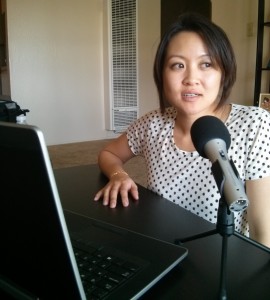
“JET gave me insight into a deeper rooted area of the Japanese culture that I appreciate. There were so many similarities of Japanese culture that I saw in my Chinese culture, and it really made me appreciate both as separate entities.” (Courtesy of Melody Wong)
By Wendy Ikemoto (Ehime-ken, 2006-2011) for JQ magazine. Wendy is a Hawaii-transplant and current Secretary of the JET Alumni Association of New York (JETAANY). When she isn’t working with librarians, you’ll find her visiting JET friends around the globe.
Melody Wong (Okayama-ken, 2011-13) is a native of Los Angeles and a member of the JET Alumni Association of Southern California (JETAASC). Prior to JET, she attended the University of California at Riverside and worked in finance for half a decade before deciding to switch things up to teach English in Japan. In December 2013, she launched the Drop That Eggroll podcast with her co-host and good friend, Alex Lau. Together, they explore subjects that span across Asian ethnicities, ranging from fun topics like pretty Korean boys and Filipino cuisine to more controversial fare like the Tiger Mother’s tips for success and ANA’s “whiteface” commercial.
Six months after DTE’s launch, JQ caught up with Melody to get the scoop on how the podcast came to be, what the future holds for it, how JET has influenced her views on the Asian culture, and why you all should be tuning in.
Can you start by describing your background for us?
I’m a second-generation Chinese American, born and raised in Los Angeles. I speak Cantonese and English fluently. The only Asian country I’ve ever lived in was Japan (two years), though I’ve traveled back and forth between China and the U.S. throughout my childhood.
Where were you on JET?
I was a JET in a tiny little town called Kibichuo-cho in the Okayama Prefecture. My town was so small and rural that even people in Okayama barely knew about it. There was no train station, so no one could really get to me unless they had a car, so I drove out everywhere all the time. I was an assistant language teacher (ALT) to multiple elementary and junior high schools.
How do you and Alex know each other?
Alex and I met through our mutual friend Larry. In high school, I was an avid member of the community service club, Key Club. My high school was part of a larger division that included lots of other local high schools, which is how I met Larry. Larry attended the Art Center College of Design and became friends with his classmate Alex. Through some social engagements, Alex and I met. All three of us, including several other friends, went on a trip to Japan in 2010, which was the trip that ultimately influenced me to join the JET Program.
AJET Professional Development Call with JET alum Anthony Bianchi
On May 7th, we held our fourth AJET Professional Development Conference Call. Our guest speaker was former JET, Mr. Anthony Bianchi (Aichi-ken, Kiyosu City, 1989-91) who now serves as a city council council member in Inuyama City, Aichi prefecture. Mr. Bianchi is often highlighted in the Japanese media and is well-known for being the first American-born elected official in Japan. Click here to read a short interview with him on AJET.net.
Mr. Bianchi discussed the inner workings of his current position, various initiatives to improve English and international communication in his community and how JETs can potentially get involved with local politics in their communities.
Click here to listen to the recording of the call on the AJET website: http://ajet.net/2014/05/13/professional-development-call-anthony-bianchi/
JETs in the News: Matt Cook featured in hometown paper
**************
Very nice article on JET alum and former AJET Chair Matthew Cook (Osaka-fu, 2007-12) that recently appeared in the newspaper of Matt’s hometown, Danville, Virginia and describes his path from the JET Program to becoming a key player in Osaka’s pioneering English education reform efforts.
Danville man appointed to Japanese board of education
By DENICE THIBODEAU
dthibodeau@registerbee.com
Thibodeau reports for the Danville Register & Bee.
May 10, 2014
When Danville native Matthew Cook headed to Osaka, Japan, in 2007 to take a job as an education specialist and trainer in the Japan Exchange and Teaching Program, little did he realize he would end up working for a Japanese government agency to completely reform how English is taught in the city.
CLICK HERE to read the rest of the article: http://m.godanriver.com/news/danville/danville-man-appointed-to-japanese-board-of-education/article_1b9620f2-d972-11e3-8adc-0017a43b2370.html?mode=jqm#.U3A0DN98uYw.facebook
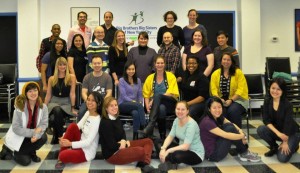
Members of the JET Alumni Association of New York volunteering in the annual Japan-a-Mania community event with Big Brothers Big Sisters of New York City, January 2014. (Courtesy of Monica Yuki)
By Eden Law (Fukushima-ken, 2010-11) for JQ magazine. Eden is JETAA New South Wales‘s webmaster, meaning he is the voice on all the online and social media for the Sydney-based chapter like Twitter, Instagram (both @jetaansw) and Facebook. Outside of JETAA, he doesn’t exist, and is merely a concept of a shadow of a dream of an enigma, wrapped in mystery and served with a side of salad.
Introduction
The following is a shamelessly biased opinion: Being a member of JETAA is fantastic. One gets to help organise and be involved in events and projects that reach the general public here in Sydney (like the Japan Festival), hang out with a great group of like-minded people that know all the best Japanese places to eat, drink and be merry, and who are rarely inhibited in any karaoke session. There is ample opportunity to new people constantly, both inside and outside that chapter’s home city’s J-community, so in a way, the JET experience never truly ends.
That’s a personal assessment of what it’s like being a member of JETAA, the alumni association for former JETs. JETAA chapters exist all over the world from where the JET Programme has drawn its recruits. They give former JETs a way to connect with their local J-community and like-minded peers, and are essentially a non-profit social organisation with a Japanese cultural bent. And because JET is made up of a diverse group of people from all walks of life, JETAA chapters have great potential as a resource with links in government, business, education, academia and social networks.
But it can’t be denied that many chapters struggle with visibility or relevancy, in attracting members to events or to join their committees. The last point is especially important, as new members help to keep the organisation dynamic and active. And while the reasons for this are different for every situation, some similar and salient points can be discerned, notably from online forum comments (like LinkedIn). While a comprehensive discussion can probably fill a volume or ten, this article will nevertheless discuss these points.
So what does JETAA have to deal with?
Let’s Talk Japan, Episode 22 – A Conversation with Dave Carlson, host of the Japanofiles Podcast
Let’s Talk Japan is a monthly, interview format podcast covering a wide range of Japan-related topics. Host Nick Harling (Mie-ken, 2001-03) lived in Japan from 2001 until 2005, including two great years as a JET Program participant in Mie-Ken. He practices law in Washington, D.C., and lives with his wife who patiently listens to him talk about Japan . . . a lot.
 In this episode, I speak with Dave Carlson, a longtime resident of Japan and host of the popular Japanofiles Podcast. Originally from Michigan, Dave first came to Japan in 1983. Since then, he has resided in Japan on and off for 21 of the last 30 years. Together, we discuss Dave’s life in Japan, his podcast, and how to have a positive experience living in Japan.
In this episode, I speak with Dave Carlson, a longtime resident of Japan and host of the popular Japanofiles Podcast. Originally from Michigan, Dave first came to Japan in 1983. Since then, he has resided in Japan on and off for 21 of the last 30 years. Together, we discuss Dave’s life in Japan, his podcast, and how to have a positive experience living in Japan.
If you’ve never listened to the Japanofiles Podcast, I highly recommend it.
Nick
If you have not already done so, be sure to “Like” the podcast on Facebook, and follow the podcast on Twitter @letstalkjapan. Additionally, please consider leaving a positive rating and/or review in iTunes.
Japan Times features JET alum Matthew Cook and his work with Osaka’s English Reformation Project Team
****************************
Very nice article on JET alum and former AJET Chair Matthew Cook (Osaka-fu, 2007-12) about his path from JET to becoming an agent of change for the Japanese English education system through is unique role with Osaka Prefecture’s Board of Education. Matt is also the founder of the Kansai JET Alumni group. FYI, you can also click here for a recent JQ profile of Matthew Cook by JETAA New South Wales‘ Eden Law (Fukushima-ken, 2010-11) .
Changing the system starts by challenging it
BY TERU CLAVEL
Just seven years after first participating in the JET program in Osaka, Matthew Cook from Danville, Virginia, is making great strides as a pioneer of English-language education reform in Japan. Having never previously been to an Asian country, Cook is now one of seven members of Osaka’s groundbreaking English Reformation Project Team, having been appointed by Osaka superintendent Toru Nakahara in 2013. With an unswerving commitment to English-language education and a little luck, Cook’s efforts may pave the path for Japan’s next generation of global leaders.
Cook applied to the JET (Japan Exchange and Teaching) program because it was “the most lucrative, stable and safe way to get to Japan.” Having run his own karate dojo in the United States, he felt the need to gain a deeper understanding of the Japanese culture behind it. However, Cook was waitlisted and needed to make a snap decision when he was offered a position within a month of the JET start date. “I had totally assumed that I wasn’t going to get in,” he says.
Cook’s initial placement was less than ideal, though. He was forewarned that the Osaka junior high school to which he was assigned might be challenging, but he was not prepared for the “few students who were stopping class altogether, violence in the classroom or kids getting up and leaving.” Read More
JQ Magazine: From JET to Japan-Related Jobs – New York Edition
By Brett Rawson (Akita-ken, 2007-09) for JQ magazine. Brett is a writer, translator, and volunteer. He currently lives in New York, where he is pursuing an MFA in creative writing at The New School and is the professional development chair for the JET Alumni Association of New York. If you have job opportunities for JET alums, an interest in presenting at JETAANY’s annual Career Forum, or want to collaborate on professional endeavors, contact him at career@jetaany.org.
If you listen closely, the age-old JET adage every situation is different can be heard echoing around the world. This is because it’s said so frequently, but that’s because there is truth to the takeaway: Paths to JET, experiences in Japan, and adventures thereafter run in every direction. But when the stories sit side by side, a greater context for, character of and meaning to the program and participants, takes solid shape.
Below are features on three New York City-based JET alumnae. Each carved a unique path to, on, and from the program, but they share one incredible thing in common: they are working at three of the largest Japan-related non-profit organizations in the world. For those interested in following in their professional footsteps, JQ would like to introduce to you them and share their advice about entering the world of Japan-related non-profits.
Meet Christy Jones, Director of Special Events at Japan Society
ALT, Shimabara-shi, Nagasaki-ken, 1995-98
Born and raised in Upstate New York, Christy received a degree in cultural anthropology and a certificate in Asian and African Languages and Literature from Duke University. That was the closest she could get to a degree in Japanese, but it wasn’t the closest she got to Japan: Her junior year, she studied abroad at Kansai Gaidai University in Osaka. But that stint didn’t quite quench her thirst for the cuisine and culture. The following fall, she applied to JET, got accepted, and returned to Japan—but this time for three years.
Christy served as an ALT at an academic high school in Shimabara-shi in Nagasaki. Thinking back, she has very fond memories of her time on JET: “As this was the pre-Internet era, I didn’t know much about Nagasaki beyond the atomic bomb,” she says. “I came to appreciate the rich international history of the area, along with the stunning natural beauty. Some of my happiest moments were traveling around Kyushu, visiting fellow JETs in their own towns, checking out the local onsens, cafes, and izakayas, and taking thousands of photos. I was befriended by a number of local residents, which allowed me to have some uniquely Japanese experiences: delivering mail as an honorary ‘Postlady for a Day’; making yakimono in a backyard pottery studio and kiln; watching a bonfire-lit Noh performance at the base of a castle; and marching in the city’s annual parade dressed like a Portuguese missionary.”
When Christy returned home, she let her experience settle. “Eventually,” she recalls, “I visited NYC to attend JETAANY’s annual Career Forum, which happened to be held at Japan Society that year.” She connected with a couple of headhunters and landed a job working as an administrative assistant for a subsidiary of Sumitomo Chemical for two years, but the work itself didn’t fulfill her: “My workday ended at 5:30 sharp, so I started volunteering at the nearby Japan Society events as an usher and ticket-taker,” which is when everything began to change.
JQ Magazine: JQ&A with Jim Breen of Monash University on WWWJDIC
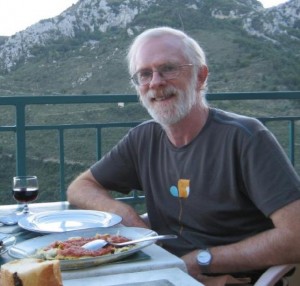
“I just spent several weeks in Finland and Sweden, where the level of English speaking is extremely good. No JET Programmes there. You can’t even argue that they are related languages—Finnish is just as foreign as Japanese, and probably has fewer gairaigo (borrowed words). How do they do it? By teaching it properly in the first place, with trained and qualified teachers.” (Courtesy of Jim Breen)
By Tim Martin (Fukui-ken, 2006-08) for JQ magazine. Tim is a neuroscience researcher and swing dancer based in New York City. He runs a blog called The Floating Lantern, where he writes about humanism and other things that matter. Lately he is trying to learn more about effective altruism and the science of applied rationality.
Jim Breen is the man behind a resource that probably every English speaker trying to learn Japanese has used: the massive WWWJDIC online dictionary. In the 1980s, Breen developed an interest in Japanese that led to him programming a Japanese dictionary for DOS as a hobby. While a professor of digital and data communications at Monash University in Melbourne, Australia, Breen continued working on the dictionary, until eventually it bloomed into an interface that connects and cross-references hundreds of thousands of entries for words, names, and kanji.
Now a recognized authority on lexicography and the Japanese language, Breen continues to work on his “hobby,” and is pursuing a Ph.D. in computational linguistics. In this exclusive interview, JQ spoke with Breen to find out how it all began, his thoughts on language teaching and the JET Programme, and how he thinks technology will affect our experiences with foreign language in the future.
How did you develop your interest in, as you say on your website, “things Japanese”? Is there a specific part of Japanese culture or media that got you hooked?
I guess my interest in Japan over other foreign countries began around 1977 when my eldest daughter, then six years old, began to study the violin using the Suzuki Method. My wife, a musician and music teacher, had heard about the Suzuki Method from a lecture and demonstration, had been extremely impressed, and had expressed an interest in our children studying in the method. From that point on Suzuki began to play an increasingly bigger part of our lives as our second and third children began to study within that method. Also, my wife began to explore teaching in the Suzuki Flute Method.
None of this interest was particularly focussed on Japan itself. In 1980, I took most of the year off work to complete my MBA (I was a budding junior executive in Telecom Australia in those days). A fellow student in our classes had studied Japanese, and impressed me by translating some of the titles of pieces in the Suzuki books. Also among the visiting lecturers was a former trade commissioner in Japan, who spoke eloquently about the importance of Japan and the need for people trained in Japanese. I recall going home that night and saying to my wife: “I think I’d like to study Japanese eventually.” She didn’t think much of the idea, and I concentrated on other things like finishing my MBA and completing a music performance diploma.
In mid-1981, my wife said one day that she thought she really should go to Japan to study teaching Suzuki flute with Toshio Takahashi at the Suzuki headquarters in Matsumoto, as there was no one in Australia teaching Suzuki flute. I liked the idea, and we agreed to go the following December and January, which is Australia’s summer period when schools are closed. Our kids, then aged ten, seven and three, could easily miss a couple of weeks school in December. I arranged two months’ Long Service Leave from Telecom (LSL is a employee right in Australia after you have worked more than 10 years with an employer), and after struggling for a short while with Teach Yourself Japanese (all Kunrei-shiki romaji), I also arranged to have weekly Japanese lessons with Brian Drover, who trained as a Japanese linguist in the Australian army during WWII.
So, in late November 1981, five Breens arrived at Narita, made our way into Tokyo, were popped on a Chuo-sen train to Matsumoto by people from the Suzuki organization, and later that day found ourselves being greeted by a welcoming party from the Nagano Girl Scouts(!). (My eldest daughter was a Brownie, so we had set the international tom-toms working.)
We spent two months in Matsumoto living in two tiny six-mat apartments rented to us by the mother of some local Girl Scouts. My wife had piano and flute pedagogy classes, my kids had lessons in violin and piano (the former with Shinichi Suzuki himself), and I did the housework, shopped, minded kids, tried to study Japanese, etc.
I guess I don’t have any particular parts of Japanese “culture” I concentrate on—my tastes are rather catholic in this regard.


